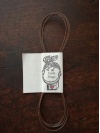The loaded strings arise from a suggestive hypothesis by Mimmo Peruffo, The Mystery of Gut Bass Strings, who tried to explain the motif of the bass octave red color in the iconography of six-eighteenth-century lutes, suggesting that it was a sort of weighting with cinnabar or minium or in any case with powdered materials with a high specific weight, including pure metal powders such as copper.
This hypothesis would seem to be confirmed by the presence of holes that are too thin in the bridges of the lutes of the time: a string in bare gut not weighted could in fact not pass through them because of the greater thickness necessary to obtain an adequate tension.
However, everything remains to explain why the cinnabar or the minium would have been used on the lutes, while on the bowed string instruments another weighting material, given that the basses are brown and not red; the brown of the lower bass can easily be explained by a bad or partial sulfurization, due to the thickness of the string, while Peruffo hypothesizes the use of metal oxides or even powdered copper, which would have been technically possible at that time.
In reality it is very strange that different weighting materials were used for lutes and bowed string instruments: by my opinion only the first ones had the weighted bass, because it was necessary to have a smaller thickness difference in the choirs with a higher octave.
My advice therefore remains to orientate, for bowed string instruments, on Cordoni Cordedrago, which maintain a powerful sound and considerable readiness even with very large diameters. The problem obviously remains that of the thickness of the string, which is more uncomfortable to feel, but it is also the reason why, as soon as it was possible, the Silver Wound strings were used and, only after this innovation (and not for an alleged previous use of loaded strings), new instruments have been created such as the cello.
Despite this, due to the strong demand for copper loaded strings also for the bowed string instruments (and for the Three-order harp), I think it is right that Cordedrago also produces this type of strings, if only because some customers fear the toxicity of cinnabar (much less than that of tuna, rich in mercury perfectly assimilable by the body!).
The particular technique of homogenization of the loading, a secret of Cordedrago workshop, indispensable for obtaining correct strings, that is not false, obviously requires a lot of time and great accuracy, so the cost of the weighted copper is much higher than that of bare gut strings.
They are particularly suitable for the bass register of Baroque violin, Viola, Viola da gamba, Oud, Lute, archlute, chitarrone or theorbo and baroque guitar and, even if not historic (but sometimes useful!), for Medieval and ethnic instruments.





